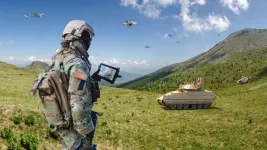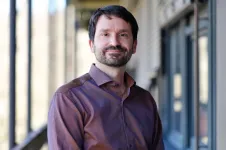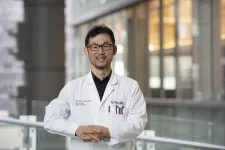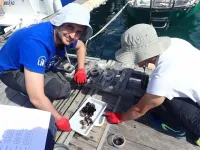(Press-News.org) ABERDEEN PROVING GROUND, Md. -- Army and Arizona State University researchers identified a set of approaches to help scientists assess how well autonomous systems and humans communicate.
These approaches build on transformational scientific research efforts led by the Army's Robotics Collaborative Technology Alliance, which evolved the state of robots from tools to teammates and laid the foundation for much of the service's existing research into how humans and robots can work together effectively.
As ideas for autonomous systems evolve, and the possibilities of ever-more diverse human-autonomy teams has become a reality; however, no clear guidelines exist to explain the best ways to assess how well humans and intelligent systems communicate, Army researchers said.
"The future Army is going to have complex teams in terms of how they will involve autonomy in different ways," said Dr. Anthony Baker, postdoctoral scientist at the U.S. Combat Capabilities Development Command, known as DEVCOM, Army Research Laboratory. "There is a clear need to be able to measure communication in those types of teams because communication is what defines teamwork. It reflects how the team thinks, plans, makes decisions and succeeds or fails.
If you can't measure how the team is doing, you can't do anything to improve their performance, their decision-making, all of those things that make it more likely for the Army to maintain a decisive overmatch on the battlefield and for the warfighter to accomplish the mission, he said.
In the recently published Human-Intelligent Systems Integration journal paper Approaches for Assessing Communication in Human-Autonomy Teams, researchers listed 11 critical approaches for assessing communication in human-autonomy teams. Baker said their focus is to change Soldier involvement with those systems.
The approach considers communication structure:
Who is saying what to whom and when
Dynamics, or how interaction patterns evolve over time
Emotion, which looks at how information is communicated through facial expressions and vocal features like tone and pitch
Content, which draws on different aspects of words and phrases themselves
"If we want Soldiers and intelligent systems to work well together, we have to have the right measurement tools to analyze and study their communication because communication is so critical to how well they can perform," Baker said.
As lead author on the paper, Baker said it won't be enough to study these things after the teams are fielded.
"We need the measurement tools while those teams and technologies are being developed by the Army," he said.
Because multi-domain operations are fundamentally dependent on improving the efficiency and optimization of communications within and between domains, the goal of this cross-cutting work is for these systems to be able to work with teams more naturally, he said.
According to Baker, this work may also provide a critical roadmap for analyzing communication in complex human-autonomy team structures such as those forecasted for Next Generation Combat Vehicle operations.
"There may be a time when a smart, load-carrying mule robot should carry a squad's extra gear completely independently and without Soldier involvement, but there is also a push in some areas to make it so that if systems do need to involve Soldiers, they can do so in a way that's more natural for the Soldiers, like working with a human teammate," Baker said.
Consider how a Soldier telling a robotic system, "I need you to take that gear up the hill and wait an hour before going to the next zone," is much easier than inputting a series of buttons and switches on a remote control.
"We want intelligence assessments, command and control decisions and other important things like that to be possible with less Soldier involvement, but we still want Soldier engagement for some things, and we want it to be easier," Baker said. "Hence why the RCTA had a large focus on making Soldier-robot interactions more efficient."
The Robotics CTA was a decade-long research initiative began in 2009 that coalesced a community of researchers from the Army, academia and industry to identify scientific gaps and move the state of the art in ground combat robotics. Strategic investments in Army-led foundational research resulted in advanced science in four critical areas of ground combat robotics that effect the way U.S. warfighters see, think, move and team.
Baker said it laid the groundwork for a lot of how the Army thinks about human-robot interaction and drove the shift in how government and industry look at robots as teammates, rather than just tools.
The laboratory's Human-Autonomy Teaming essential research program, or HAT ERP, continues down paths started in the RCTA, which laid broad building blocks for how to describe, model, design and implement new ways of partnering humans and robots, which are intelligent systems with physical forms.
"RCTA was not interested in explaining or providing ways to study communication between human teammates, instead being aimed at how humans and robots communicate," Baker said. "Our work looks at it from the perspective that we will need ways to study the communication of any type of team-whether or not those teams currently involve any number of robots or autonomy. We want to be agnostic to the overall makeup of the team, so we provide communication assessments suitable for many different scenarios."
These communication assessment approaches also apply to Soldier-only teams as well.
"Imagine a future human-autonomy team that has to re-task an autonomous vehicle to go join another platoon, and now the team is just humans only," he said. "Our work seeks to provide the literature with ways to analyze communication in those teams, no matter what they look like or what they're supposed to do, so that we can draw conclusions about how well they are working together and accomplishing their goals."
Future research will seek to validate some of the approaches identified in the paper using datasets collected from Next Generation Combat Vehicle lab studies and field experiments, Baker said.
INFORMATION:
Researchers from the Faraday Institution's SOLBAT project have made a significant step in understanding how and why solid-state batteries (SSBs) fail. A paper, published in Nature Materials on 22 April, provides answers to one important piece of the scientific puzzle.
To make step changes in electric vehicle (EV) battery range and safety at a lower cost, new battery chemistries that are "beyond lithium ion" must be developed. SSBs are one such promising technology, but mass market adoption has been held back by several key technical challenges that cause the battery to fail when charged and discharged.
SSBs can short circuit after repeating charging and discharging. One well-recognised cause of battery failure is the growth of dendrites, branching networks of lithium that ...
An evolutionary biologist from the University of Bonn brought a new octopus species to light from depths of more than 4,000 meters in the North Pacific Ocean. The sensational discovery made waves in the media a few years ago. Researchers in Bonn have now published the species description and named the animal "Emperor dumbo" (Grimpoteuthis imperator). Just as unusual as the organism is the researchers' approach: in order to describe the new species, they did not dissect the rare creature, but instead used non-destructive imaging techniques. The results have now been published in the prestigious journal BMC Biology.
In the summer of 2016, Dr. Alexander ...
A continental-scale network of conservation sites is likely to remain effective under future climate change scenarios, despite a predicted shift in key species distributions.
New research, led by Durham University and published in the journal Frontiers in Ecology and Evolution, investigates the impacts of potential climate change scenarios on the network of Important Bird and Biodiversity Areas (IBAs) across the Caribbean, and Central and South America.
The research was carried out in collaboration with Senckenberg Biodiversity and Climate Research Centre, BirdLife International and the National Audubon Society.
IBAs are sites identified as being internationally important for the conservation of bird populations, with over 13,000 ...
There are many different types of cancer, but they all have one thing in common: errors in the signals that control normal cell behaviour can cause uncontrolled cell growth and cell division, leading to a tumour. An enzyme called SHP2 plays a key role in this regard. SHP2 is a signalling molecule that in its activated state stimulates cell proliferation. In a normal healthy body, the rates of cell proliferation and cell death are balanced and tumours do not develop. However, if SHP2 becomes too active, the number of cells being created outweighs the number that die, which can lead to the formation of dangerous tumours. Enhanced SHP2 activity resulting from genetic ...
Researchers at the University of Cincinnati say a regulatory protein found in skeletal muscle fiber may play an important role in the body's fight or flight response when encountering stressful situations.
The protein, fast skeletal myosin binding protein-C (fMyBP-C), plays a foundational role in the proper regulation of contractile structure and function in the body's fast twitch muscles -- these muscles produce sudden bursts of power to sprint into action, jump or lift heavy objects. Fast skeletal myosin binding protein-C modulates the speed and force of fast skeletal muscle contraction.
"This response ...
People with type 2 diabetes tend to have poorer muscle function than others. Now a research team at Lund University in Sweden has discovered that in type 2 diabetes, a specific gene is of great importance for the ability of muscle stem cells to create new mature muscle cells. The findings are published in Nature Communications.
"In people with type 2 diabetes, the VPS39 gene is significantly less active in the muscle cells than it is in other people, and the stem cells with less activity of the gene do not form new muscle cells to the same degree. The gene is important when muscle cells absorb sugar from blood and build new muscle. Our study is the first ever to link this gene to type 2 diabetes", says Charlotte Ling, professor of epigenetics at Lund University who led ...
Recently study on synthetic approaches toward polycyclic aromatic hydrocarbons (PAHs) as graphene with a well-defined structure has attracted much attention. A research group in Ehime University has been studying the synthesis and fundamental properties of pyrrole-fused azacoronene (HPHAC), a nitrogen-containing PAH. HPHACs are composed of electron-rich pyrroles, which are easily oxidized, and their dicationic species in particular exhibit unique features such as global aromaticity based on macrocyclic π-conjugation. However, all the compounds reported so far have bulky ...
An interdisciplinary group of Spanish scientists, bringing together biologists and chemists from the Universities of Seville, Huelva, the Autonomous University of Madrid and the Institute of Marine Sciences of Andalusia of the CSIC in Cadiz, have just published the results of their pioneering research studying the management of marinas. The group of scientists, led by the US professor José Manuel Guerra García, studied in detail the sediments in Andalusia's marinas and has proposed a new index, the MEPI (Marinas Environmental Pollution Index) to quantify the level of contamination in these ports.
There has been a proliferation of marinas in recent ...
The giant star featured in this latest Hubble Space Telescope anniversary image is waging a tug-of-war between gravity and radiation to avoid self-destruction. The star, called AG Carinae, is surrounded by an expanding shell of gas and dust -- a nebula -- that is shaped by the powerful winds of the star. The nebula is about five light-years wide, which equals the distance from here to our nearest star, Alpha Centauri.
The huge structure was created from one or more giant eruptions several thousand years ago. The star's outer layers were blown into space, the expelled material ...
How do the billions of cells communicate in order to perform tasks? The cells exert force on their environment through movement - and in doing so, they communicate. They work as a group in order to infiltrate their environment, perform wound healing and the like. They sense the stiffness or softness of their surroundings and this helps them connect and organize their collective effort. But when the connection between cells is distrubeddisturbed, a situation just like when cancer is initiated, can appear.
Assistant Professor Amin Doostmohammadi at the Niels Bohr Institute, University of Copenhagen has investigated the mechanics of cell movement and connection ...








